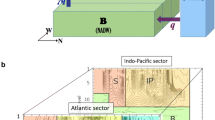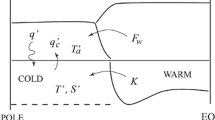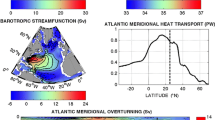Abstract
A box model of the inter-hemispheric Atlantic meridional overturning circulation is developed, including a variable pycnocline depth for the tropical and subtropical regions. The circulation is forced by winds over a periodic channel in the south and by freshwater forcing at the surface. The model is aimed at investigating the ocean feedbacks related to perturbations in freshwater forcing from the atmosphere, and to changes in freshwater transport in the ocean. These feedbacks are closely connected with the stability properties of the meridional overturning circulation, in particular in response to freshwater perturbations. A separate box is used for representing the region north of the Antarctic circumpolar current in the Atlantic sector. The density difference between this region and the north of the basin is then used for scaling the downwelling in the north. These choices are essential for reproducing the sensitivity of the meridional overturning circulation observed in general circulation models, and therefore suggest that the southernmost part of the Atlantic Ocean north of the Drake Passage is of fundamental importance for the stability of the meridional overturning circulation. With this configuration, the magnitude of the freshwater transport by the southern subtropical gyre strongly affects the response of the meridional overturning circulation to external forcing. The role of the freshwater transport by the overturning circulation (M ov ) as a stability indicator is discussed. It is investigated under which conditions its sign at the latitude of the southern tip of Africa can provide information on the existence of a second, permanently shut down, state of the overturning circulation in the box model. M ov will be an adequate indicator of the existence of multiple equilibria only if salt-advection feedback dominates over other processes in determining the response of the circulation to freshwater anomalies. M ov is a perfect indicator if feedbacks other than salt-advection are negligible.










Similar content being viewed by others
Notes
Since the equation of state is linear, only temperature (or salinity) differences are physically relevant.
That is, changes slow enough to leave the system close to the steady state.
References
Allison LC, Johnson HL, Marshall DP, Munday DR (2010) Where do winds drive the Antarctic Circumpolar Current? Geophys Res Lett 37:L12605
Arzel O, England MH, Saenko OA (2010) The impact of wind-stress feedback on the stability of the Atlantic meridional overturning circulation. J Clim 24:1965–1984
Callies J, Marotzke J (2012) A simple and self-consistent geostrophic-force-balance model of the thermohaline circulation with boundary mixing. Ocean Sci 8:49–63
Cessi P, Wolfe CL (2009) Eddy-driven buoyancy gradients on eastern boundaries and their role in the thermocline. J Phys Oceanogr 39:1595–1614
Cimatoribus AA, Drijfhout SS, den Toom M, Dijkstra HA (2012) Sensitivity of the Atlantic meridional overturning circulation to south Atlantic freshwater anomalies. Clim Dyn 39:2291–2306
Cunningham SA, Kanzow T, Rayner D, Baringer MO, Johns WE, Marotzke J, Longworth HR, Grant EM, Hirschi JJ-M, Beal LM, Meinen CS, Bryden HL (2007) Temporal variability of the Atlantic meridional overturning circulation at 26.5 degrees n. Science 317:935–938
De Boer AM, Gnanadesikan A, Edwards NR, Watson AJ (2010) Meridional density gradients do not control the Atlantic overturning circulation. J Phys Oceanogr 40:368–380
den Toom M, Dijkstra HA, Cimatoribus AA, Drijfhout SS (2012) Effect of atmospheric feedbacks on the stability of the Atlantic meridional overturning circulation. J Clim 25:4081–4096
Doedel EJ, Oldeman BE (2009) AUTO-07P: Continuation and bifurcation software for ordinary differential equations. Concordia University, Montreal, Concordia university edition
Drijfhout SS, Weber SL, Swaluw E (2011) The stability of the MOC as diagnosed from model projections for pre-industrial, present and future climates. Clim Dyn 37:1575–1586
Ferrari R, Wunsch C (2009) Ocean circulation kinetic energy: reservoirs, sources, and sinks. Annu Rev Fluid Mech 41:253–282
Friocourt Y, Drijfhout S, Blanke B, Speich S (2005) Water mass export from drake passage to the Atlantic, Indian, and Pacific Oceans: a lagrangian model analysis. J Phys Oceanogr 35:1206–1222
Gnanadesikan A (1999) A simple predictive model for the structure of the oceanic pycnocline. Science 283:2077–2079
Hawkins E, Smith RS, Allison LC, Gregory JM, Woollings TJ, Pohlmann H, de Cuevas B (2011) Bistability of the Atlantic overturning circulation in a global climate model and links to ocean freshwater transport. Geophys Res Lett 38:L10605
Huisman SE, den Toom M, Dijkstra HA, Drijfhout SS (2010) An indicator of the multiple equilibria regime of the Atlantic meridional overturning circulation. J Phys Oceanogr 40:551–567
Johnson HL, Marshall DP (2002) A theory for the surface Atlantic response to thermohaline variability. J Phys Oceanogr 32:1121–1132
Johnson HL, Marshall DP, Sproson DAJ (2007) Reconciling theories of a mechanically driven meridional overturning circulation with thermohaline forcing and multiple equilibria. Clim Dyn 29:821–836
Levermann A, Fürst JJ (2010) Atlantic pycnocline theory scrutinized using a coupled climate model. Geophys Res Lett 37:L14602
Longworth H, Marotzke J, Stocker TF (2005) Ocean gyres and abrupt change in the thermohaline circulation: a conceptual analysis. J Clim 18:2403–2416
Lumpkin R, Speer K (2007) Global ocean meridional overturning. J Phys Oceanogr 37(10):2550–2562
Marsh R, Hazeleger W, Yool A, Rohling EJ (2007) Stability of the thermohaline circulation under millennial co2 forcing and two alternative controls on Atlantic salinity. Geophys Res Lett 34:L03605
Marshall DP, Pillar HR (2011) Momentum balance of the Wind-Driven and meridional overturning circulation. J Phys Oceanogr 41:960–978
Nikurashin M, Vallis G (2012) A theory of the interhemispheric meridional overturning circulation and associated stratification. J Phys Oceanogr 42:1652–1667
Oliver KIC, Watson AJ, Stevens DP (2005) Can limited ocean mixing buffer rapid climate change. Tellus A 57:676–690
Rahmstorf S (1996) On the freshwater forcing and transport of the Atlantic thermohaline circulation. Clim Dyn 12:799–811
Rahmstorf S, Crucifix M, Ganopolski A, Goosse H, Kamenkovich I, Knutti R, Lohmann G, Marsh R, Mysak LA, Wang Z, Weaver AJ (2005) Thermohaline circulation hysteresis: a model intercomparison. Geophys Res Lett 32:L23605
Rooth C (1982) Hydrology and ocean circulation. Progr Oceanogr 11:131–149
Scott JR, Marotzke J, Stone PH (1999) Interhemispheric thermohaline circulation in a coupled box model. J Phys Oceanogr 29:351–365
Sijp WP, England MH (2006) Sensitivity of the Atlantic thermohaline circulation and its stability to basin-scale variations in vertical mixing. J Clim 19:5467–5478
Sijp WP, Gregory JM, Tailleux R, Spence P (2012) The key role of the western boundary in linking the AMOC strength to the North-South pressure gradient. J Phys Oceanogr 42:628–643
Silvia L (2011) Garzoli and Ricardo Matano. The South Atlantic and the Atlantic meridional overturning circulation. Deep-Sea Res Pt II 58:1837–1847
Spall MA (2004) Boundary currents and watermass transformation in marginal seas. J Phys Oceanogr 34:1197–1213
Stommel H (1961) Thermohaline convection with two stable regimes of flow. Tellus 13:224–230
de Vries P, Weber SL (2005) The Atlantic freshwater budget as a diagnostic for the existence of a stable shut down of the meridional overturning circulation. Geophys Res Lett 32:L09606
Wolfe CL, Cessi P (2011) The adiabatic pole-to-pole overturning circulation. J Phys Oceanogr 41:1795–1810
Wolfram Research, Inc (2010) Mathematica, 8.0 edn. Wolfram Research, Inc., Champaign
Acknowledgments
A.A.C. acknowledges the Netherlands Organization for Scientific Research (NWO) for funding in the ALW program. The authors would like to thank three anonymous reviewers for their constructive, insightful and very useful comments.
Author information
Authors and Affiliations
Corresponding author
Appendix: Derivation of E a | 0 M_ov and \(\Updelta_E\)
Appendix: Derivation of E a | 0 M_ov and \(\Updelta_E\)
To compute the E a value needed to bring M ov to zero with q S > 0, the system (10) has to be solved.
In the non diffusive limit κ → 0 Eq. (10e) reduces to q S − q N = 0, a second order equation in D, which can be solved giving as positive solution:
This result can be substituted into Eqs. (10a–10d), and salinity can be eliminated giving:
The latter is solved for E a giving E a | 0 M_ov in the case of κ → 0:
(14) can be combined with Eq. (9) to give \(\Updelta_E\) in the non diffusive limit, Eq. (11).
The method outlined for the non diffusive limit can be used for the model including vertical diffusion as well. Also in this case, the mathematics involved is very simple on conceptual grounds, but the large expressions obtained render the problem tedious with pencil and paper. The final result is obtained with Mathematica software. Eq. (10d), in this case a third order algebraic equation, can be solved for pycnocline depth, and the positive solution reads:
After eliminating salinity, Eqs. (10a–10d) reduce again to (13), and E a | 0 M_ov is still given by Eq. (14), but with D| M_ov 0 and q N | 0 M_ov for the finite vertical diffusion case.
The difference between E a | 0 q_N and E a | 0 M_ov then gives \(\Updelta_E\), which can be written as:
In the limit of no vertical diffusion, q e | 0 q_N = q Ek if q N = 0, and thus \(\Updelta_E\) reduces to:
which can be written in the form of Eq. (11) when q N | 0 M_ov is written explicitly.
Rights and permissions
About this article
Cite this article
Cimatoribus, A.A., Drijfhout, S.S. & Dijkstra, H.A. Meridional overturning circulation: stability and ocean feedbacks in a box model. Clim Dyn 42, 311–328 (2014). https://doi.org/10.1007/s00382-012-1576-9
Received:
Accepted:
Published:
Issue Date:
DOI: https://doi.org/10.1007/s00382-012-1576-9




